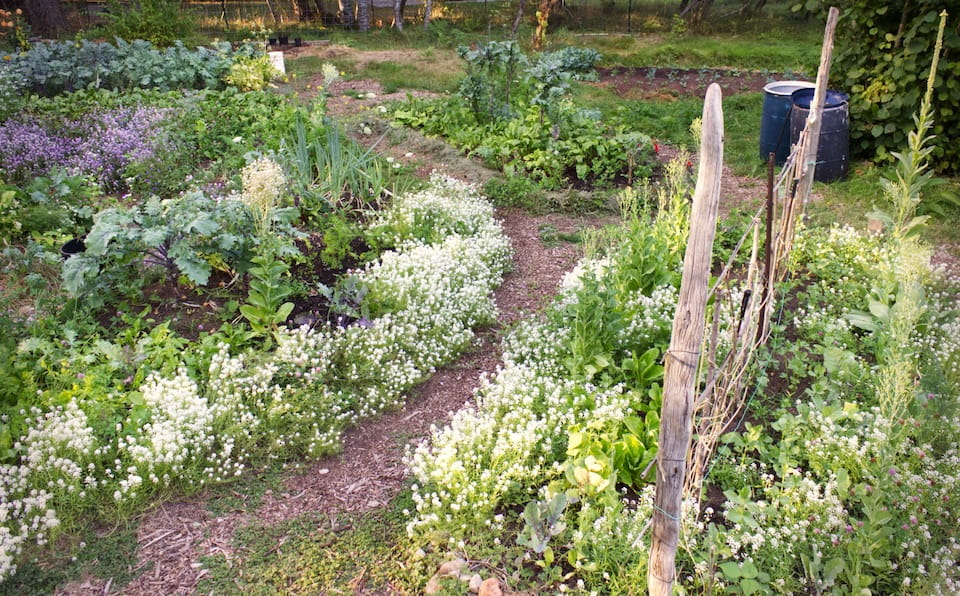
Cultivating Plant Communities
Polyculture planting involves growing multiple plant species within the same area or plot. It can also be known as mixed cropping or intercropping. This approach contrasts with monoculture, where a single crop is cultivated over a large area. Polyculture planting offers a range of benefits in a garden. It promotes biodiversity, pest management, soil health, and ecosystem resilience.
History of Polyculture
Polyculture has part of indigenous people’s horticultural practices across the world for thousands of years:
-
Native American tribes like the Iroquois have long used companion planting methods such as the “Three Sisters” combination of corn, beans, and squash.
-
In South America, the Inca and other cultures utilized diverse crop systems in their terraced mountainside farms.
-
Japanese farmer Masanobu Fukuoka developed a “natural farming” approach. This involved planting rice alongside barley and clover, as well as hundreds of varieties of fruits, vegetables, and grains in complex guilds.
In the 20th century, the rise of industrial agriculture led to a shift towards large-scale monocultures. However, interest in sustainable polyculture methods has resurged in recent decades. Today, polyculture is practiced in many parts of the world:
-
Tropical agroforestry systems like the Skarù·ręʔ (Tuscarora) Food Forest in New York State demonstrate the use of nut trees in polyculture to support Indigenous food systems.
-
In China, the seaweed Gracilaria is widely cultured in ponds and tanks, often in polyculture with fish, shrimp and bivalves.
-
Northwest Himalayan Mountain Farming systems incorporate a productive mix of intercropping and mono-cropping .
-
Perennial grassland polycultures containing native grasses and forbs are being researched as bioenergy crops in the US.
Some of the Key Advantages of polyculture planting:
-
Biodiversity Enhancement: Polyculture planting increases plant diversity within the garden, providing a variety of habitats and food sources for beneficial insects, birds, and other wildlife. A diverse plant community supports a more robust ecosystem, improving ecological balance and resilience to environmental stressors.
-
Pest Management: Different plant species in a polyculture garden may have varying susceptibility to pests and diseases. By mixing crops, gardeners can disrupt pest and disease cycles. It can make it more difficult for pests to locate and attack their preferred hosts. Additionally, some plants emit compounds that attract natural predators. This helps repel or control pests, reducing the need for chemical pesticides.
-
Soil Health Improvement: Polyculture planting can enhance soil health by diversifying root structures, nutrient uptake patterns, and organic matter inputs. Deep-rooted plants can help break up compacted soil layers, improve soil structure, and access nutrients from deeper soil layers. Furthermore, diverse plant residues contribute to soil organic matter, supporting beneficial microbial activity and nutrient cycling.
-
Nutrient Cycling: Different plant species have varying nutrient requirements and uptake abilities. By growing a mix of crops with complementary nutrient needs, polyculture planting promotes efficient nutrient cycling within the garden. For example, leguminous plants such as beans and peas fix atmospheric nitrogen into the soil. After cutting, their nitrogen-rich residues can benefit neighbouring plants.
-
Competition Reduction: In a polyculture garden, plants may compete for resources such as sunlight, water, and nutrients. However, this competition is often balanced by complementary relationships where certain plants help each other thrive. For example, tall plants can provide shade and shelter for smaller, more delicate species. Shallow-rooted plants may benefit from deeper-rooted companions that access moisture and nutrients from deeper soil layers.
-
Resilience to Environmental Stress: Polyculture gardens are inherently more resilient to environmental fluctuations, such as drought, extreme temperatures, or heavy rainfall. The diverse array of plant species can adapt to a wider range of conditions. This can reduce the risk of crop failure and provide a more reliable harvest year-round.
-
Maximized Use of Space and Resources: By utilizing vertical space, planting in layers, and intercropping compatible species, polyculture gardens can maximize productivity and resource efficiency. This intensive planting approach makes efficient use of limited garden space. It can allow gardeners to grow a greater variety of crops in the same area.
-
Polyculture planting offers numerous benefits for both gardeners and the environment. By embracing diversity and complexity in garden design and management, gardeners can create thriving and resilient ecosystems that produce abundant harvests while promoting sustainability and biodiversity.
Quick Guide to Polyculture Practices:
-
Research complementary plant combinations and experiment with different groupings
-
Mix fast-growing and slow-maturing crops to optimize the timing of harvests
-
Use groundcovers and deep-rooted plants to fill different ecological niches
-
Plant pest-deterring herbs and flowers among vegetables
-
Allow some plants to go to seed to support pollinators and encourage self-seeding
-
Incorporate nitrogen-fixing legumes to build soil fertility
While polycultures can be more complicated to plan and manage compared to monocultures, their long-term benefits for soil health, pest management, biodiversity and climate resilience make them a key strategy for sustainable food production. With a little research and creativity, even small-scale home gardeners can apply these ancient techniques to create beautiful, bountiful and biodiverse growing spaces.
- https://nfu.org/2020/10/12/the-indigenous-origins-of-regenerative-agriculture/
- https://www.semanticscholar.org/paper/Ancient-and-Traditional-Agriculture-in-South-Taylor-Chiou/8f1031f9862a93e4470ed1d0685a0e91d89d4913
- https://www.semanticscholar.org/paper/Pruning-the-Past%2C-Shaping-the-Future%3A-David-Mas-and-Chou/7569e4295aedfa58cb5293b8586ecce39e3003b1?utm_source=direct_link
- https://www.semanticscholar.org/paper/The-Skar%C3%B9%C2%B7r%C4%99%CA%94-(Tuscarora)-Food-Forest-in-Research-Bosco-Thomas/9004c791ee8426a9d0413d2ca5eb180cff737818
- https://www.semanticscholar.org/paper/Propagation-and-cultivation-of-Gracilaria-in-China.-Delin/9248d5a095cee527445460341c3168faf07275db
- https://www.semanticscholar.org/paper/Energy-and-Economic-Efficiency-of-the-Mountain-A-in-Singh-Rao/5266f6d5d2ba39ddfde52e6d9d4a63354dd73373
- https://www.semanticscholar.org/paper/Native-Perennial-Grassland-Species-for-Bioenergy%3A-Mangan-Sheaffer/10dfacd6fb246c8193194e12d6f7e3310d8526df
- https://www.semanticscholar.org/paper/Challenge-of-transition%3A-the-history-of-a-case-by-Canellas-Olivares/346d41f367f5e8532f5e7dd1cc7d7503a634a7e5